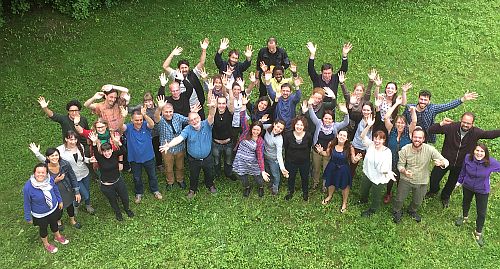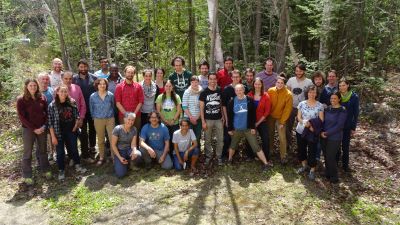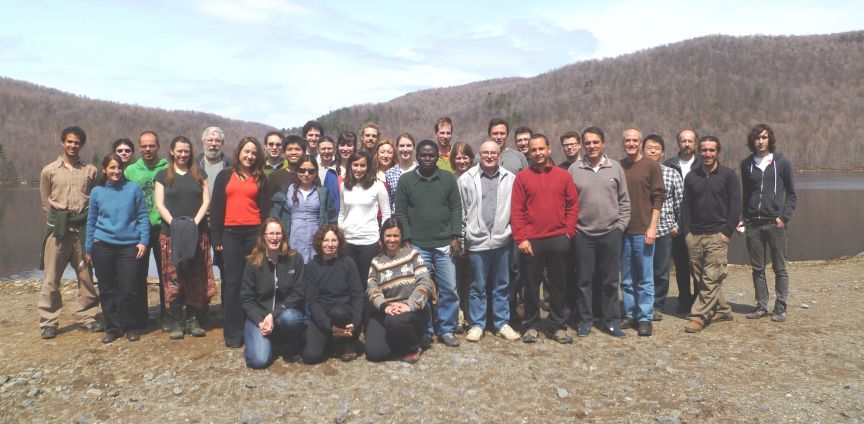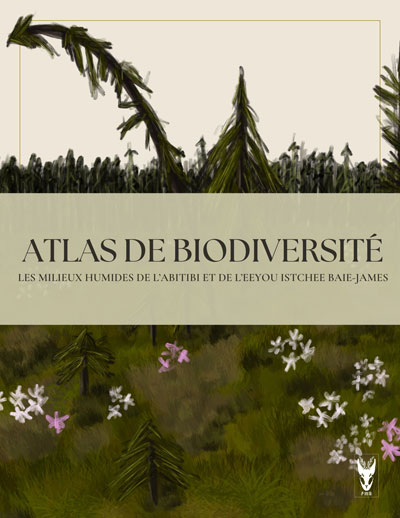International Traits Summer School 2025
Species traits : a functional approach to biodiversity, from organisms to ecosystems
Prochaine formation
La prochaine formation aura lieu à l'Université Laval (Québec) du 15 au 20 juin 2025!
Description
Les cycles biogéochimiques des écosystèmes sont dynamisés par l’absorption des minéraux et l’assimilation du carbone par les plantes. La compréhension des processus d’investissement de ces nutriments et du carbone et les différences entre les espèces, les types fonctionnels et les biomes représentent un domaine important de recherche en écologie végétale. Cette compréhension est une base importante afin d’accomplir la mise à l’échelle pour la modélisation des modifications potentielles des processus biogéochimiques et la réponse de la végétation aux changements climatiques.
En 2025, il s'agit de la 10ème édition du cours gradué thématique du CEF sur les traits fonctionnels des plantes. Il est commandé par le Centre d'étude de la forêt (CEF), le Centre de la Science de la Biodiversité du Québec (CSBQ ![]() ) et l'Institut national de la recherche scientifique (INRS).
) et l'Institut national de la recherche scientifique (INRS).
Le cours est offert pour crédit aux étudiants MSc et PhD: Sujets spéciaux FOR - 7006 (3 crédits, été) et les étudiants d'autres universités québecoises peuvent s'inscrire via le BCI ![]() .
.
Inscription et informations pratiques
Le prix est 300 CAN$ (environ 245 US$ ou 240 euros) incluant la réception initiale et les lunchs. Pour appliquer, envoyer un CV et lettre de motivation à alison.munson@sbf.ulaval.ca. Cette information est nécessaire pour la sélection des étudiants, qui sera faite en mars. La date d'échéance pour une application est le 11 mars 2025 et l'acceptation sera pour la fin mars.
Objectifs
- Se familiariser avec les concepts et la théorie liés à l’approche des ‘plant traits’
- Explication des traits et niveaux d’organisation en écologie : organismes, communautés, écosystèmes (fonctionnements et services des écosystèmes)
- Approches quantitatives afin d'évaluer la diversité fonctionnelle
- Démontrer la mise en application des concepts dans le cadre des changements planétaires (utilisation des terres, climat)
- Se familiariser avec les banques de données des traits et leur utilisation
Formateurs
Les formateurs confirmés pour 2025 incluent Eric Garnier, Alison Munson, Juan Posada, Bill Shipley, Francesco de Bello, Isabelle Aubin, Marie-Laure Navas et Peter Reich.
Contenu (Plan du cours  )
)
Un syllabus détaillé sera disponible en mars. Plusieurs lectures sont disponibles ici avant le cours afin de bien vous préparer. Cette année les étudiants seront impliqués dans un atelier thématique autour les sujets de l'approche traits dans la recherche courante. Prenez note que l’évaluation pour les étudiants inscrits inclura la participation aux discussions et une présentation du projet de recherche au groupe.
Participants et photos
| Année | Lieu | Liste des participants | Photos du cours |
| 2022 | Espagne, Valence | N.D. | N.D. |
| 2019 | France, Porquerolles | N.D. | N.D. |
| 2018 | Colombie, Villa de Leyva | N.D. | N.D. |
| 2016 | République Tchèque | Voir | Voir |
| 2015 | Québec | Voir | Voir |
| 2013 | Colombie | Voir | Voir |
| 2012 | France | Voir | Voir |
| 2011 | Québec | Voir | Voir |
| 2009 | Québec | Voir | Voir |
Lectures
Lectures classiques obligatoires
- Lavorel, S. & Garnier, E. (2002) Predicting changes in community composition and ecosystem functioning from plant traits: revisiting the Holy Grail
 . Functional Ecology, 16: 545-556.
. Functional Ecology, 16: 545-556.
- Violle, C., Navas, M. L., Vile, D., Kazakou, E., Fortunel, C., Hummel, I. & Garnier, E. (2007) Let the concept of trait be functional!
 Oikos, 116 (5): 882-892.
Oikos, 116 (5): 882-892.
- Westoby, M., Falster, D.S., Moles, A.T., Vesk, P.A. & Wright, I.J. (2002) Plant ecological strategies: Some leading dimensions of variation between species.
 ,Annual Review of Ecology and Systematics 33: 125-159.
,Annual Review of Ecology and Systematics 33: 125-159.
- Wright I. J., P.B. Reich, M. Westoby, D. Ackerly, Z. Baruch, J. Cavender-Bares, T. Chapin, H. Cornelissen, M. Diemer, E. Garnier, J. Gulias, K. Hikosaka & Lamont, B. (2004) The worldwide leaf economics spectrum
 . Nature 428:821-827.
. Nature 428:821-827.
- Díaz, S., Kattge, J., Cornelissen, J.H.C., Wright, I.J., Lavorel, S., Dray, S., Reu, B., Kleyer, M., Wirth, C., Colin Prentice, I., Garnier, E., Bönisch, G., Westoby, M., Poorter, H., Reich, P.B., Moles, A.T., Dickie, J., Gillison, A.N., Zanne, A.E., Chave, J., Wright, J.S., Sheremet’ev, S.N., Jactel, H., Baraloto, C., Cerabolini, B., Pierce, S., Shipley, B., Kirkup, D., Casanoves, F., Joswig, J.S., Günther, A., Falczuk, V., Rüger, N., Mahecha, M.D., Gorné, L.D. (2016) The global spectrum of plant form and function.
 Nature 529, 167-171.
Nature 529, 167-171.
- Shipley, B., De Bello, F., Cornelissen, J.H.C., Laliberté, E., Laughlin, D.C., Reich, P.B. (2016) Reinforcing loose foundation stones in trait-based plant ecology
 Oecologia 180, 923-931.
Oecologia 180, 923-931.
- Shipley, B., Vile, D., & Garnier, E. (2006) From plant traits to plant communities: a statistical mechanistic approach to biodiversity
 . Science 314: 812-814.
. Science 314: 812-814.
Livre de référence
- Garnier, E, Navas M-L and Grigulis, K. (2016) Plant Functional Diversity - Organismic traits, community structure, ecosystem properties. Oxford University Press.
- Garnier, E and Navas M-L. (2013) Diversité fonctionnelle des plantes: Traits des organisms, structure des communautés, propriétés des écosystèmes. De boeck. 353 p.
- Grime, J.P. (2001) Plant Strategies, Vegetation Processes, and Ecosystem Properties, 2nd Edition edn. John Wiley & Sons, Chichester.
Protocoles standards
- Cornelissen J.H.C et al. (2003) A handbook of protocols for standardised and easy measurement of plant functional traits worldwide.
 Australian Journal Botany, 51: 335-380.
Australian Journal Botany, 51: 335-380.
- Pérez-Harguindeguy N. et al. (2013) New handbook for standardised measurement of plant functional traits worldwide.
 Australian Journal of Botany 61, 167–234.
Australian Journal of Botany 61, 167–234.
Lectures des profs 2018
- Adler, P.B., Salguero-Gómez, R., Compagnoni, A., Hsu, J.S. & Ray-mukherjee, J. (2014) Functional traits explain variation in plant life history strategies. Proc. Natl. Acad. Sci., 111, 740–745.
- Freschet G.T., Valverde-Barrantes O.J., Tucker C.M., Craine J.M., McCormack M.L., Violle C., Fort F., Blackwood, C.B. et al. (2017) Climate, soil and plant functional types as drivers of global fine-root trait variation. Journal of Ecology, 105, 1182-1196.
- Jiminez-Alfaro, B. Silveira, F.A.O., Fidelis, A., Poschlod, P., Commander, L.E. (2016) Seed germination traits can contribute better to plant community ecology. Journal of Vegetation Science 27: 637–645.
- Valverde-Barrantes O.J., Freschet G.T., Roumet C., Blackwood C.B. (2017) A worldview of root traits: the influence of ancestry, growth form, climate and mycorrhizal association on the functional trait variation of fine root tissues in seed plants. New Phytologist, 215, 1562-1573.
- Yang, J., Cao, M. and Swenson, N.G. (2018) Why Functional Traits Do Not Predict Tree Demographic Rates. TREE https://doi.org/10.1016/j.tree.2018.03.003
Autres lectures prioritaires
- de Bello, F., Lavorel, S., Díaz, S., Harrington, R., Cornelissen, J.H.C., Bardgett, R.D., Berg, M.P., Cipriotti, P., Feld, C.K., Hering, D., Martins da Silva, P., Potts, S.G., Sandin, L., Sousa, J.P., Storkey, J., Wardle, D.A., Harrison, P.A. (2010) Towards an assessment of multiple ecosystem processes and services via functional traits.
 Biodiversity and Conservation, 19, 2873-2893.
Biodiversity and Conservation, 19, 2873-2893.
- De Deyn, G.B., Cornelissen, J.H.C., Bardgett, R.D. (2008) Plant functional traits and soil carbon sequestration in contrasting biomes.
 Ecology Letters, 11, 516–531.
Ecology Letters, 11, 516–531.
- Garnier, E., Cortez, J. Billés, G. Navas, M.-L., Roumet, C., Debussche, M., Laurent, G., Blanchard, A., Aubry, D., Bellmann, A., Neill, C. and Toussaint, J.-P. (2004) Plant functional markers capture ecosystem properties during secondary succession
 . Ecology, 85: 2630-2637.
. Ecology, 85: 2630-2637.
- Garnier, E., Navas, M.-L. (2012) A trait-based approach to comparative functional plant ecology: concepts, methods and applications for agroecology: A review.
 Agronomy for Sustainable Development.
Agronomy for Sustainable Development.
- Götzenberger, L., de Bello, F., Bråthen, K.A., Davison, J., Dubuis, A., Guisan, A., Lepš, J., Lindborg, R., Moora, M., Pärtel, M., Pellissier, L., Pottier, J., Vittoz, P., Zobel, K., Zobel, M. (2012) Ecological assembly rules in plant communities—approaches, patterns and prospects. Biological Reviews 87, 111-127.
- Grime, J.P. (1977) Evidence for the existence of three primary strategies in plants and its relevance to ecological and evolutionary theory
 . American Naturalist, 111, 1169-1194.
. American Naturalist, 111, 1169-1194.
- Grime, J.P. (1998) Benefits of plant diversity to ecosystems: immediate filter and founder effects
 . Journal of Ecology, 86: 902-910.
. Journal of Ecology, 86: 902-910.
- Kattge, J. et al. (2011) TRY- a global database of plant traits.
 Global Change Biology 17: 2905-2935.
Global Change Biology 17: 2905-2935.
- Keddy, P.A. (1992) Assembly and Response Rules - 2 Goals for Predictive Community Ecology . Journal of Vegetation Science, 3(2): 157-164.
- Laughlin, D.C. (2014) The intrinsic dimensionality of plant traits and its relevance to community assembly Δ. Journal of Ecology 102, 186-193.
- Moles, A.T., Leishman, M.R. (2008) The seedling as part of a plant’s life history strategy.
 In: Leck, M.A., Parker, V.T., Simpson, R.L. (Eds.), Seedling Ecology and Evolution. Cambridge University Press, Cambridge, pp. 217–238.
In: Leck, M.A., Parker, V.T., Simpson, R.L. (Eds.), Seedling Ecology and Evolution. Cambridge University Press, Cambridge, pp. 217–238.
- Naeem, S. and Bunker D.E. (2009) TraitNet: furthering biodiversity research through the curation, discovery, and sharing of species trait data Δ. (Chap 20) In Biodiversity, Ecosystem Functioning, & Human Wellbeing: An Ecological and Economic Perspective. (Edited by Naeem, S., Bunker,D.E., Hector, A., Loreau, M. and Perrings, C.), Oxford University Press, Oxford, UK, pages : 281-289.
- Pavoine, S. and Bonsall, M.B. (2011) Measuring biodiversity to explain community assembly: a unified approach.
 Biological Reviews, 86: 792–812. doi: 10.1111/j.1469-185X.2010.00171.x
Biological Reviews, 86: 792–812. doi: 10.1111/j.1469-185X.2010.00171.x
- Petchey, O.L. and Gaston, K.J. (2006) Functional diversity: back to basics and looking forward. Δ Ecology Letters, 9: 741–758. doi: 10.1111/j.1461-0248.2006.00924.x
- Poorter, H., Niinemets, Ü., Poorter, L., Wright, I.J., Villar, R. (2009) Causes and consequences of variation in leaf mass per area (LMA): a meta-analysis.
 New Phytologist, 182, 565-588.
New Phytologist, 182, 565-588.
- Shipley, B. (2007) Comparative plant ecology as a tool for integrating across scales
 . Annals of Botany, 99: 965-966.
. Annals of Botany, 99: 965-966.
- Violle, Cyrille et al. (2012) The return of the variance: intraspecific variability in community ecology.
 Trends in Ecology & Evolution 27 (4): 244 - 252.
Trends in Ecology & Evolution 27 (4): 244 - 252.
Et plus si vous avez le temps…
- Birouste, M., Kazakou, E., Blanchard, A. and Roumet, C. (2012) Plant traits and decomposition: are the relationships for roots comparable to those for leaves?
 Annals of Botany, 109: 463-472.
Annals of Botany, 109: 463-472.
- Garnier, E., Lavorel, S., Ansquer, P., Castro, H., Cruz, P., Dolezal, J., Eriksson, O., Fortunel, C., Freitas, H., Golodets, C., Grigulis, K., Jouany, C., Kazakou, E., Kigel, J., Kleyer, M., Lehsten, V., Lepš, J., Meier, T., Pakeman, R., Papadimitriou, M., Papanastasis, V.P., Quested, H., Quétier, F., Robson, M., Roumet, C., Rusch, G., Skarpe, M., Sternberg, M., Theau, J.-P., Thébault, A., Vile, D. & Zarovali, M. (2007) Assessing the effects of land use change on plant traits, communities and ecosystem functioning in grasslands: a standardized methodology and lessons from an application to 11 European sites
 . Annals of Botany, doi : 10.1093/aob/mcl215.
. Annals of Botany, doi : 10.1093/aob/mcl215.
- Kikuzawa, K & Lechowicz, M.J. (2006) Towards a synthesis of relationships among leaf longevity, instantaneous photosynthetic rate, lifetime leaf carbon gain and the gross primary production of forests
 . American Naturalist, 168: 373-383.
. American Naturalist, 168: 373-383.
- Leps, J., de Bello, F., Lavorel, S., Berman, S. (2006) Quantifying and interpreting functional diversity of natural communities: practical considerations matter.
 Preslia 78(4): 481-501.
Preslia 78(4): 481-501.
- Niklas, K. J., Cobb, E.D., Niinemets, U., Reich, P.B., Sellin, A., Shipley, B., Wright, I.J. (2007) ‘‘Diminishing returns’’ in the scaling of functional leaf traits across and within species groups
 . Proceedings of the National Academy of Sciences 104: 8891-8896.
. Proceedings of the National Academy of Sciences 104: 8891-8896.
- Michener, W.K. and Jones, M.B. (2012) Ecoinformatics: supporting ecology as a data-intensive science Δ. Trends in ecology & evolution 27: 85-93.
- Orwin, K.H., Buckland, S.M., Johnson, D., Turner, B.L., Smart, S., Oakley, S. and Bardgett, R.D. (2010) Linkages of plant traits to soil properties and the functioning of temperate grassland
 . Journal of Ecology, 98(5): 1074-1083.
. Journal of Ecology, 98(5): 1074-1083.
- Ostle, N.J. et al. (2009) Integrating plant-soil interactions into global scale carbon cycle models.
 Journal of Ecology, 97: 851-863.
Journal of Ecology, 97: 851-863.
- Reich, P.B., Wright, I.J., Lusk, C.H. (2007) Predicting leaf functional traits from simple plant and climate attributes using the GLOPNET global data set
 . Ecological Applications, 17: 1982-1988.
. Ecological Applications, 17: 1982-1988.
- Shipley, Bill, Lechowicz, M.J., Wright, Ian and Reich, P.B. (2006) Fundamental tradeoffs generating the worldwide leaf economics spectrum
 . Ecology, 87(3): 535-541.
. Ecology, 87(3): 535-541.
- Villéger S., Mason N. W. H. and Mouillot D. (2008) New multidimensional functional diversity indices for a multifaceted framework in functional ecology. Δ Ecology 89 (8): 2290-2301
- Violle, C., Reich, P.B., Pacala, S.W., Enquist, B.J., Kattge, J. (2014) The emergence and promise of functional biogeography. Proceedings of the National Academy of Sciences 111, 13690-13696.













